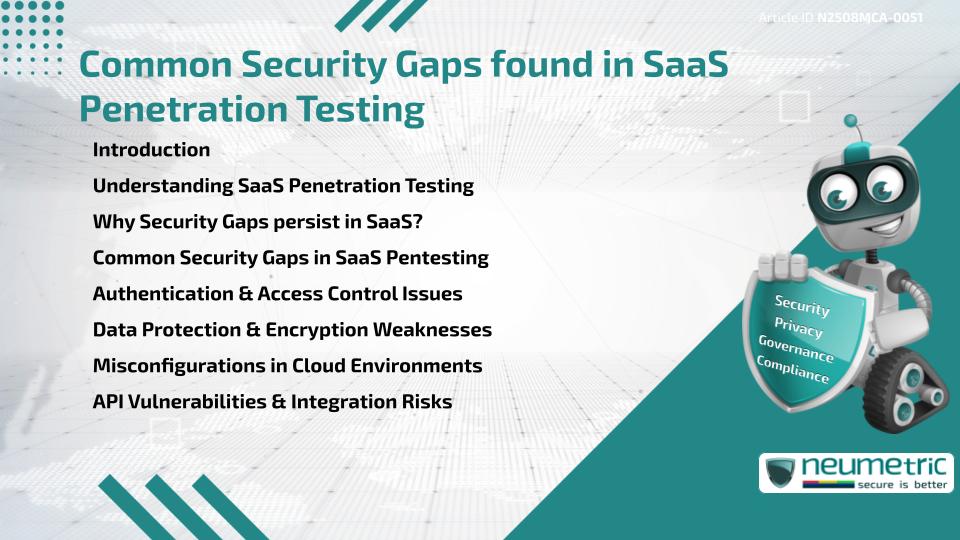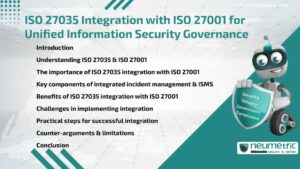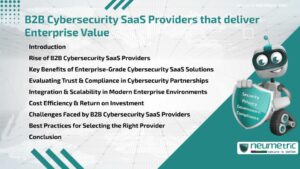Table of Contents
ToggleIntroduction
Software-as-a-Service [SaaS] Platforms are now central to how Businesses operate, offering scalability, flexibility & cost-efficiency. However, the very qualities that make SaaS attractive also introduce Security challenges. Penetration Testing helps uncover these Weaknesses, yet recurring issues often surface. Understanding the common Security Gaps in SaaS Pentesting is essential for Organisations that want to strengthen Defenses, maintain Customer Trust & meet Compliance Requirements. This article explores the most frequently identified Vulnerabilities & their implications.
Understanding SaaS Penetration Testing
SaaS Penetration Testing is a simulated Cyberattack designed to identify Vulnerabilities in SaaS Applications. Unlike Traditional Testing, SaaS Pentesting must consider unique factors such as Multi-tenancy, Cloud Service Provider Integrations & User Access from diverse locations. The objective is to identify flaws before Attackers exploit them. Regular Pentesting is not only a best practice but often a requirement for Compliance with Standards like SOC 2 & ISO 27001.
Why Security Gaps persist in SaaS?
Despite advancements in SaaS Security, Gaps persist due to factors such as rapid Deployment Cycles, complex Integrations & reliance on Third Party Services. Developers often prioritise feature delivery over Security Hardening, leaving weaknesses unaddressed. Additionally, shared responsibility models between SaaS Providers & Customers can lead to confusion over who manages specific Security Controls. These conditions make SaaS Platforms particularly prone to recurring Vulnerabilities.
Common Security Gaps in SaaS Pentesting
Pentesting Reports reveal several recurring issues that Organisations must address to secure SaaS Platforms effectively. The common Security Gaps in SaaS Pentesting include:
- Weak Authentication & Access Control
- Poor Data Protection & Encryption
- Cloud Misconfigurations
- Insecure APIs & Third Party Integrations
Each of these areas poses significant Risks if not remediated promptly.
Authentication & Access Control Issues
Authentication & authorisation weaknesses are among the most frequent findings. Examples include Weak Password Policies, lack of Multi-factor Authentication [MFA], and improper Role-based Access Control [RBAC]. These flaws make it easier for attackers to gain unauthorised access. Strong Identity Management practices, including MFA & periodic access reviews, are critical for addressing these Risks.
Data Protection & Encryption Weaknesses
Data Security remains a cornerstone of SaaS trustworthiness. Yet pentests often reveal issues such as Unencrypted Data in transit, improper Key Management or lack of Encryption for Sensitive Data at rest. These weaknesses expose Organisations to Data Breaches, Regulatory Penalties & Reputational Damage. Ensuring robust Encryption Protocols & secure Key Storage are essential steps to mitigate these Risks.
Misconfigurations in Cloud Environments
Cloud misconfigurations are a common source of SaaS Vulnerabilities. Examples include overly permissive Access Controls, exposed Storage Buckets & unpatched Virtual Machines. Attackers frequently exploit these oversights to gain unauthorised access or extract Sensitive Information. Continuous Configuration monitoring & automated Compliance Checks can significantly reduce these Risks.
API Vulnerabilities & Integration Risks
SaaS Platforms often rely heavily on APIs to connect with other Services. However, APIs are a common Attack Vector. Vulnerabilities such as inadequate Authentication, excessive Data Exposure & improper Rate Limiting can be exploited by malicious Actors. Thorough API Security Testing, combined with strict Input Validation & Monitoring, is vital to securing these Integration points.
Takeaways
- Understanding the common Security Gaps in SaaS Pentesting helps Organisations proactively address Vulnerabilities before Attackers exploit them.
- The most frequent issues include Weak Authentication, Encryption Flaws, Cloud Misconfigurations & Insecure APIs.
- Implementing stronger Access Controls, robust Encryption, automated Configuration Monitoring & thorough API Testing is essential.
- By addressing these areas, SaaS Providers can strengthen their Security Posture and build greater Trust with Customers.
FAQ
What is the goal of SaaS Penetration Testing?
The goal is to simulate real-world attacks to identify & remediate Vulnerabilities in SaaS Applications before malicious Actors exploit them.
Why are Authentication issues so common in SaaS Pentesting?
Authentication issues arise because Organisations often rely on Weak Password Policies or fail to implement Multi-factor Authentication.
How do Misconfigurations create security Risks in SaaS?
Misconfigurations such as exposed Storage Buckets or permissive Access Controls can provide Attackers with direct entry points to sensitive Systems.
Why are APIs a frequent target during Pentesting?
APIs often expose critical functions & data. If poorly secured, they can be exploited for unauthorised Access, Data theft or Service disruption.
How often should SaaS Penetration Testing be conducted?
At minimum, testing should occur annually or whenever significant changes are made to the SaaS Application or Infrastructure.
Can Encryption weaknesses lead to Compliance failures?
Yes, inadequate Encryption practices can result in Violations of Standards such as GDPR, SOC 2 & ISO 27001.
Do shared responsibility models affect SaaS Security Gaps?
Yes, confusion over whether the Provider or Customer is responsible for certain Controls often leads to unaddressed Vulnerabilities.
Need help for Security, Privacy, Governance & VAPT?
Neumetric provides organisations the necessary help to achieve their Cybersecurity, Compliance, Governance, Privacy, Certifications & Pentesting needs.
Organisations & Businesses, specifically those which provide SaaS & AI Solutions in the Fintech, BFSI & other regulated sectors, usually need a Cybersecurity Partner for meeting & maintaining the ongoing Security & Privacy needs & requirements of their Enterprise Clients & Privacy conscious Customers.
SOC 2, ISO 27001, ISO 42001, NIST, HIPAA, HECVAT, EU GDPR are some of the Frameworks that are served by Fusion – a SaaS, multimodular, multitenant, centralised, automated, Cybersecurity & Compliance Management system.
Neumetric also provides Expert Services for technical security which covers VAPT for Web Applications, APIs, iOS & Android Mobile Apps, Security Testing for AWS & other Cloud Environments & Cloud Infrastructure & other similar scopes.
Reach out to us by Email or filling out the Contact Form…





